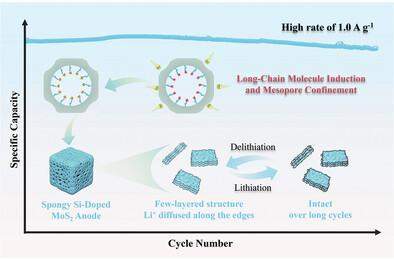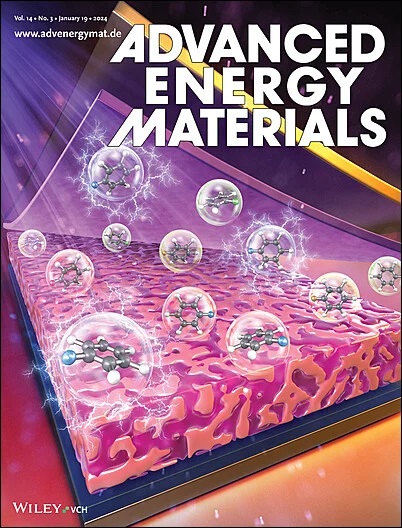Spongy Silicon-Doped MoS2 via Long-Chain Molecule Induction and Mesopore Confinement for Ultra-Stable Lithium-Ion Storage
IF 24.4
1区 材料科学
Q1 CHEMISTRY, PHYSICAL
引用次数: 0
Abstract
Layered transition metal dichalcogenides (LTMDs), such as MoS2, are promising anode materials for high-energy-density lithium-ion batteries (LIBs) due to their high specific capacities. However, their practical applications are hindered by poor cycling stability resulting from the instable structure during charge/discharge and inherently low electronic conductivity. To tackle these issues, herein, this study presents the design and synthesis of spongy silicon-doped MoS2 induced by the long-chain molecules in mesopores. The material consists of few-layered nanofragments with high porosity, resulting in abundant edge sites and sulfur vacancies. These structural features can promote Li+ transport and accommodate electrode volume changes during charge/discharge. Electrochemical and theoretical analyses reveal that silicon doping enhances the electronic conductivity of MoS2, while the nanostructure design enables reversible Li⁺ diffusion along the edges, distinct from Li+ storage in the interlayers of conventional MoS2 anodes. Notably, the material delivers a high reversible capacity of 767.9 mAh g−1 at 0.1 A g−1 and exhibits remarkable rate capability. Moreover, it demonstrates superior cycling stability with over 83% capacity retention even after 1000 cycles at 1.0 A g−1, outperforming most existing MoS2-based anode materials. This work paves a new way for designing high-performance LTMD-based anodes for LIBs and beyond.

求助全文
约1分钟内获得全文
求助全文
来源期刊

Advanced Energy Materials
CHEMISTRY, PHYSICAL-ENERGY & FUELS
CiteScore
41.90
自引率
4.00%
发文量
889
审稿时长
1.4 months
期刊介绍:
Established in 2011, Advanced Energy Materials is an international, interdisciplinary, English-language journal that focuses on materials used in energy harvesting, conversion, and storage. It is regarded as a top-quality journal alongside Advanced Materials, Advanced Functional Materials, and Small.
With a 2022 Impact Factor of 27.8, Advanced Energy Materials is considered a prime source for the best energy-related research. The journal covers a wide range of topics in energy-related research, including organic and inorganic photovoltaics, batteries and supercapacitors, fuel cells, hydrogen generation and storage, thermoelectrics, water splitting and photocatalysis, solar fuels and thermosolar power, magnetocalorics, and piezoelectronics.
The readership of Advanced Energy Materials includes materials scientists, chemists, physicists, and engineers in both academia and industry. The journal is indexed in various databases and collections, such as Advanced Technologies & Aerospace Database, FIZ Karlsruhe, INSPEC (IET), Science Citation Index Expanded, Technology Collection, and Web of Science, among others.
 求助内容:
求助内容: 应助结果提醒方式:
应助结果提醒方式:


